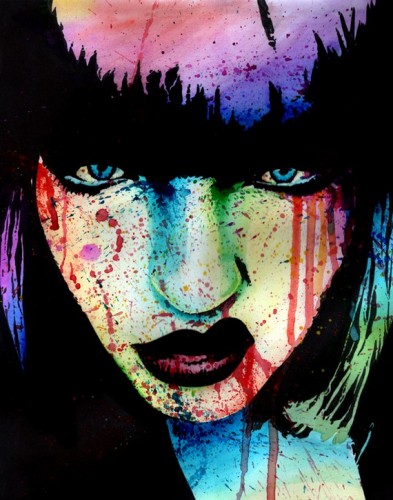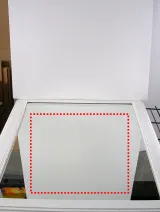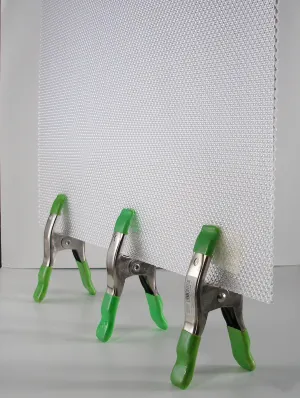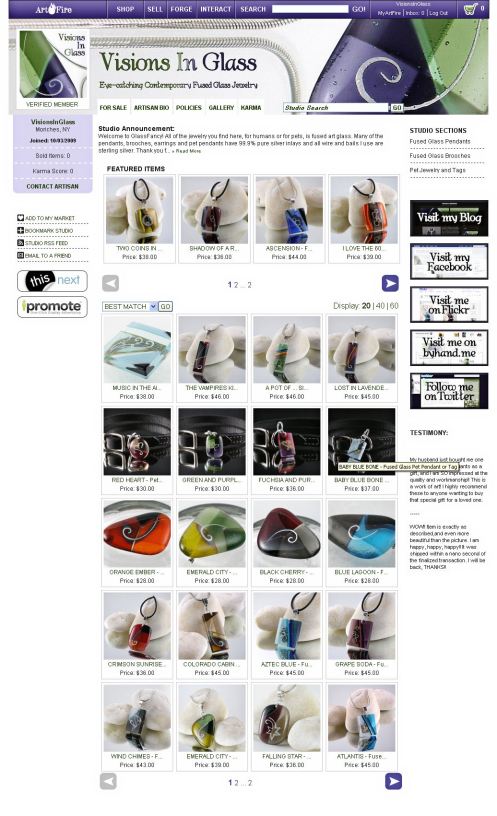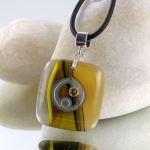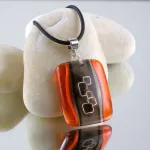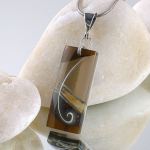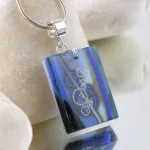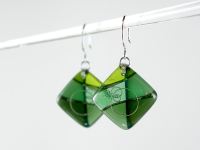Carissa Rose; Art with Attitude
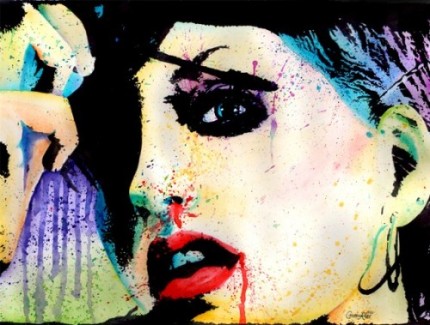 The other day, I stumbled upon Carissa Rose’s work on Artfire and I’m enthralled!
The other day, I stumbled upon Carissa Rose’s work on Artfire and I’m enthralled!
She is a tattooist in training but also works with pencil and paintbrush. In her own words, her “art is inspired by tattoos and people” and it isn’t hard to relate to her statement once you see her work.
The first thing that hits you (or me, as it were) is the contrast. “In your face” color cuts the deepest black into pieces. No shades of gray; no compromise!
Most of her subjects are young women but although femininity is dripping off of them like the colorful run-lines of paint that you can see in so many places, they are certainly not stereotypical beauty-queens without a mind of their own. They are characters, and as real, with all the facets of darkness, as the fields of perfect inky black.
Her work skillfully speaks to the observer. In many of her pieces you have strong eyes staring straight at you from the painting, involving you in the scene.
This is some serious art with attitude!
Thank you to Carissa Rose for the permission to display her work!
Artwork shown ©Carissa Rose Stevens. Do not use, edit or publish without authorized consent.
My Tips and Tricks for Product Photography, Part 2
Welcome to the second part of My Tips and Tricks for Product Photography!
In the first part I discussed the photo setup that I have tinkered together. Now we are going to take a closer look at photo backgrounds and props, photo composition and angles and depth.
All these aspects play into one another and are undoubtedly intertwined.
Before starting to shoot photos of your creations, I think it would be wise to sit down and think about the style and feel of your products. Does your needlework have a romantic flair? Do your soaps emphasis the natural and earthy? Does your jewelry fall smack in the middle of steam punk?
In your photos it is important that the background does not clash with your product style. You want it to subtly support the feel your product gives off or supply a perfectly neutral background.
In my opinion, it is also unwise to put your item in front of such a strong or busy background that it goes under and becomes anything but the main focus of the photo.
In the following photo I have tried to do all the wrong things to show you what I mean.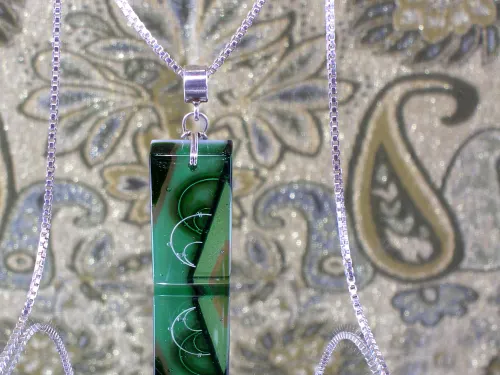
My fused glass is contemporary and modern, so I use very neutral props like near white stones that I found on the beach or other backgrounds that have simple but flowing lines. Since my jewelry also makes a strong color statement and is at least partially transparent, I usually tend to choose white or near white backgrounds rather than dark ones.
For metal objects, for example, a dark background would provide a better contrast and makes the item stand out better. Or for a steam punk product, to choose another example, props with sharp corners and angles are probably a better choice than backgrounds with soft flowing lines.
My main point here is to really think about what compliments your product and don’t just go for the next best item that is in arm’s reach as a background.
Now let’s look at a few more things you can do to make your photos more than just informative for your buyers.
Photo composition is a very important tool that is at your disposal.
I encountered the rules for composition some time in school and university but I have to admit that I never consciously make my composition decisions based on any rules. I pretty much don’t remember them and I simply decide based on whether it looks good to me or not.
However, there are a gazillion articles on the web about the rules of composition in photography. And I do encourage you to read up on it but since I am not a photographer I would rather not regurgitate someone else’s knowledge here.
If you don’t feel like reading whole articles and you don’t feel like getting all into theory about it, let me stress the most important rule, in my book, in just a few words.
Don’t center your main focus (namely your item) in the photo!
Compare the following two very similar photos.
The photo of the centered donut looks a lot more static. Placing it slightly off-center adds direction and makes the photo look more interesting.
Obviously, there are always exceptions to the rules and you should follow your instinct when it tells you to break them. I do it all the time.
Now, let’s have a look at the difference angles can make.
I believe it is always a good idea to provide one perfect frontal view among the photos that you are allowed for each item listing. But I also believe that it would be a mistake to make this frontal view photo the first photo your potential buyers see.
The first visual encounter that people have with your product should be the hottest and most gorgeous photo you have and it doesn’t always have to even show the entire item. This is your chance to capture people’s attention and make them click further into your listing.
Consider the effect of the following angles.
I usually take a few shoots from each angle and then pick the one that speaks to me most as my first representative photo. There probably is some kind of theoretical rule and explanation to the effect of each angle, but honestly, I just let my gut decide.
However, I don’t think there has been even a single instant when the frontal view was the best looking angle. And when it comes to items made of glass, you can only really show transparencies and texture when you angle your photos.
The next and last aspect that I would like to discuss in this part of the series is depth.
It mostly applies when you have more than one item in your photo but depending on your background, you can create a sense of depths with that as well.
Compare the following two almost identical photos. I chose a very simple and plain view to try to not sidetrack the eye.


You can create foreground, middle ground, and background by placing several items at different distances from the camera and shooting the photo at a very shallow angle. You can force your camera to increase or decrease the resulting blur. I found a great article that explains it really well. You can check it out HERE.
There is also another way to create this depth blur. A lot of photo editing software programs have special functions to achieve this effect. But that will be part of the discussion in the third part of this series.
I hope this post was helpful and if you have any comments or suggestions, please feel free to share!
My Tips and Tricks for Product Photography, Part 1
Recently, I was asked to write a blog post on how I photograph my products. I was a little surprised to get that request because, although I know my photos have been getting a lot better from when I started, I have never stopped to think that they might really stand out to someone.
So I am very flattered and happy to share what I have found works for me.
A lot of the following tips and tricks have come about as a result of trial and error so you have to bear in mind that there might be a better solution that I haven’t thought of and if you would like to add anything, I would be most grateful!
The first topic that seems to be inherently important when talking about photography is the camera.
When I started selling my fused glass jewelry, I already had a camera and it wasn’t an expensive one or one with very many special features. At the time I had to make due and by doing so, I learned a little more about my camera and in the end, made it work. I still use the same camera and I don’t see a reason for me to buy a “better” one any time soon.
I use the Olympus SP-310 and in my opinion, I couldn’t have bought a better camera for the money.
Initially, I used the preset categories like the ‘Portrait’ or the ‘Indoor’ setting but realized pretty soon that I have a lot more control over what the photo looks like when I use the manual setting. By using the manual settings, you are able to determine the shutter speed and therefore have influence over the type and how much light you have to use, which is especially important when you photograph glass. When you take pictures of very shiny and reflective surfaces, you might need to reduce the light or diffuse it extensively to avoid large areas of bright white reflection. In that case you can increase the time that the shutter stays open to allow for more of the light to enter the lense and therefore still have a well-lit photo. In conclusion: more light –> faster shutter speed, less light –> slower shutter speed.
There is so much more technical information about the ‘physics’ of taken great photos but I have to admit, my understanding ends right here.
The next thing that is very important to have is a tripod.
When you use the manual settings and slow shutter speeds, the slightest movement of the camera is going to blur the whole picture.
I picked up a simple tripod for roughly $25 from Best Buy.
Next, we are getting to the light box setup.
A light box, in general, is a box made of some kind of material that permits light to shine through but diffuses it to a certain degree. The box is placed in the spotlight of several light sources and the item to be photographed sits inside the box and is therefore illuminated.
A light box doesn’t really have to be a box. The important thing is that the item is illuminated from all sides except the bottom and the light needs to be filtered through some kind of diffuser.
Here is a picture of my light box setup in my basement. It’s not very professional looking but it serves the purpose wonderfully and it didn’t cost me an arm and a leg.
There are several components to my setup.
- the base
- the back panel
- the mirror
- the side diffuser panels
- the top diffuser panel
- the light sources
Let’s go over each component separately.
For the base I use a couple of sturdy boxes that raise the working area up to a comfortable level. You want to make sure that you work at a level where you don’t have to exchange good photos for back pain.
I use a grate that was left over from my ferret cage as the main work surface but you can use a piece of ply wood or anything else you have available as well.
On top of the main work surface I place a mirror. It’s an old bathroom wall mirror and you can see it underneath the mannequin with the white frame.
The reason for using a mirror is that it amplifies the light you shine onto it and it also diffuses it further. In addition, it adds a certain esthetic due to the reflection it produces and you can create some cool effects with textured sheet glass, for example. The third merit of the mirror is the opportunity to quickly change the background color without having to move the item by simply standing up a colored foam board behind the scene.
And that leads us to the back panel.
The foam boards come in several different colors and can be purchased at stores like Michaels or Stamples etc.
Simply lean it again the wall behind the scene.
Check out the series of photos with different boards. The red dotted rectangle is the area you place your item in and take your photo.
The diffuser panels are called acrylic light diffuser panels for fluorescent lights and can be bought at Home Depot or Lowe’s.
I glued two of them together to increase the degree of diffusion and to make them a little more sturdy. Then I clamped on steel spring clamp and stood the panel up on the hand piece of the clamps like in the picture below.
There also is a little top diffuser panel that you can’t see in the photo of my setup. It’s basically a smaller version of the standing panels and is attached in front of the light source that hangs from the ceiling.
And that is the perfect transition to the light sources.
I figured the easiest way to create freely movable light sources are clamp lights like this one. I use two on each side clamped down in two different heights and one that is clamped in a frontal/top position on the ceiling behind the little top diffuser panel.
Most importantly though are the light bulbs you are using. They have to be daylight bulbs, meaning they produce the entire spectrum of light. Click here for an example of the right bulbs.
Wow, I did not expect this post to get so long! So I think it will be best to declare this the first part of a series of posts.
Stay tuned for more Tips and Tricks for Product Photography coming soon!

